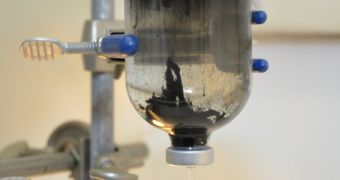Back in 1980, researchers proposed that structures similar to black smokers may represent the points where life originated here on Earth. These black smokers are hydrothermal vents on the ocean floor that release chemicals from our planet's mantle, through its crust, and to the surface. Now, a comprehensive study of this theory and related researches proves that the water world theory has a lot of merit.
For nearly 35 years, scientists have been studying the possibility that hydrothermal vents indeed constituted the point of origin for life on a planet that features a much wetter and harsher environment than what we see today and where ultraviolet radiations battered everything in their path. This process is referred to as the “submarine alkaline hydrothermal emergence of life” hypothesis.
One of its main tenets is that free electrical energy produced naturally in these submarine environments is what led to the development of the earliest, simplest cells. These cells grew and developed and eventually formed all the organisms we see in the world today, from bacteria and fungi to birds, mammals, and humans.
For this new study, researchers at NASA assembled all available field and laboratory data as well as theoretical researches and models ever gathered and developed of the water world theory. The work was led by experts with the Jet Propulsion Laboratory (JPL) in Pasadena, California, and with the Astrobiology Institute at the Ames Research Center (ARC) in Moffett Field, California.
Scientists at JPL and Icy Worlds team at the Institute basically created a unified image of this entire theory, integrating all available data and predictions into a massive dataset. The image that emerged was that black smokers were most likely not the source of life. However, the team found that another type of hydrothermal vent, first proposed by JPL researcher Michael Russell in 1989, was the most likely environment to support the development of early life.
These proposed vents were basically underwater springs, carrying cooler, gentler, and more alkaline fluids. By comparison, black smokers are extremely acidic and usually pump out a mixture of water and dangerous chemicals at great temperatures. Until 14 years ago, only black smokers had been discovered in the world' oceans, but things changed in 2000.
At that time, scientists found the Lost City, a towering complex of alkaline vents that lies in the North Atlantic. “Life takes advantage of unbalanced states on the planet, which may have been the case billions of years ago at the alkaline hydrothermal vents. Life is the process that resolves these disequilibria,” says Russell, the lead author of the new study.
Details of the research appear in the April issue of the esteemed scientific journal Astrobiology.
The disequilibria Russell refers to occur between the environments around alkaline hydrothermal vents and the overall environment of the ancient ocean, which was far more acidic than it is today. This difference caused a series of proton and electron transfer processes between the two environments that could have easily driven the evolution of early life, the team argues.
“Within these vents, we have a geological system that already does one aspect of what life does. Life lives off proton gradients and the transfer of electrons. By testing this origin-of-life hypothesis in the lab at JPL, we may explain how life might have arisen on these other places in our solar system or beyond, and also get an idea of how to look for it,” says Laurie Barge.
“Michael Russell’s theory originated 25 years ago and, in that time, JPL space missions have found strong evidence for liquid water oceans and rocky sea floors on Europa and Enceladus. We have learned much about the history of water on Mars, and soon we may find Earth-like planets around faraway stars,” concludes the JPL expert, who was the second author on the new paper.

 14 DAY TRIAL //
14 DAY TRIAL //